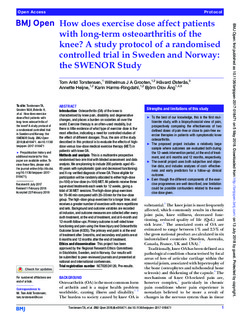| dc.contributor.author | Torstensen, Tom Arild | |
| dc.contributor.author | Grooten, Wilhelmus J A | |
| dc.contributor.author | Østerås, Håvard | |
| dc.contributor.author | Heijne, Annette | |
| dc.contributor.author | Harms-Ringdahl, Karin | |
| dc.contributor.author | Äng, Björn Olov | |
| dc.date.accessioned | 2018-09-10T10:36:13Z | |
| dc.date.available | 2018-09-10T10:36:13Z | |
| dc.date.created | 2018-05-08T08:14:17Z | |
| dc.date.issued | 2018 | |
| dc.identifier.citation | BMJ Open. 2018, 8 1-12. | nb_NO |
| dc.identifier.issn | 2044-6055 | |
| dc.identifier.uri | http://hdl.handle.net/11250/2561718 | |
| dc.description.abstract | Introduction
Osteoarthritis (OA) of the knee is characterised by knee pain, disability and degenerative changes, and places a burden on societies all over the world. Exercise therapy is an often-used modality, but there is little evidence of what type of exercise dose is the most effective, indicating a need for controlled studies of the effect of different dosages. Thus, the aim of the study described in this protocol is to evaluate the effects of high-dose versus low-dose medical exercise therapy (MET) in patients with knee OA.
Methods and analysis
This is a multicentre prospective randomised two-arm trial with blinded assessment and data analysis. We are planning to include 200 patients aged 45–85 years with symptomatic (pain and decreased functioning) and X-ray verified diagnosis of knee OA. Those eligible for participation will be randomly allocated to either high-dose (n=100) or low-dose (n=100) MET. All patients receive three supervised treatments each week for 12 weeks, giving a total of 36 MET sessions. The high-dose group exercises for 70–90 min compared with 20–30 min for the low-dose group. The high-dose group exercises for a longer time, and receives a greater number of exercises with more repetitions and sets. Background and outcome variables are recorded at inclusion, and outcome measures are collected after every sixth treatment, at the end of treatment, and at 6-month and 12-month follow-ups. Primary outcome is self-rated knee functioning and pain using the Knee Injury and Osteoarthritis Outcome Score (KOOS). The primary end point is at the end of treatment after 3 months, and secondary end points are at 6 months and 12 months after the end of treatment.
Ethics and dissemination
This project has been approved by the Regional Research Ethics Committees in Stockholm, Sweden, and in Norway. Our results will be submitted to peer-reviewed journals and presented at national and international conferences. | nb_NO |
| dc.language.iso | eng | nb_NO |
| dc.publisher | BMJ Publishing Group | nb_NO |
| dc.rights | Navngivelse 4.0 Internasjonal | * |
| dc.rights.uri | http://creativecommons.org/licenses/by/4.0/deed.no | * |
| dc.title | How does exercise dose affect patients with long-term osteoarthritis of the knee? A study protocol of a randomised controlled trial in Sweden and Norway: the SWENOR Study | nb_NO |
| dc.type | Journal article | nb_NO |
| dc.type | Peer reviewed | nb_NO |
| dc.description.version | publishedVersion | nb_NO |
| dc.source.pagenumber | 1-12 | nb_NO |
| dc.source.volume | 8 | nb_NO |
| dc.source.journal | BMJ Open | nb_NO |
| dc.identifier.doi | 10.1136/bmjopen-2017-018471 | |
| dc.identifier.cristin | 1584016 | |
| dc.description.localcode | © Article author(s) (or their employer(s) unless otherwise stated in the text of the article) 2018. All rights reserved. No commercial use is permitted unless otherwise expressly granted. This is an Open Access article distributed in accordance with the Creative Commons Attribution Non Commercial (CC BY-NC 4.0) license. | nb_NO |
| cristin.unitcode | 194,65,30,0 | |
| cristin.unitname | Institutt for nevromedisin og bevegelsesvitenskap | |
| cristin.ispublished | true | |
| cristin.fulltext | original | |
| cristin.qualitycode | 1 | |

